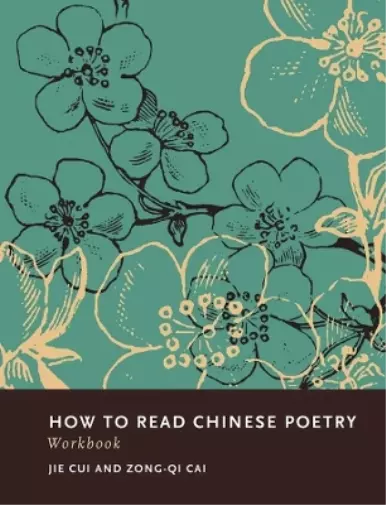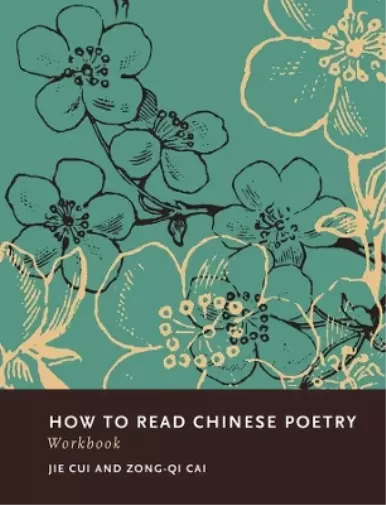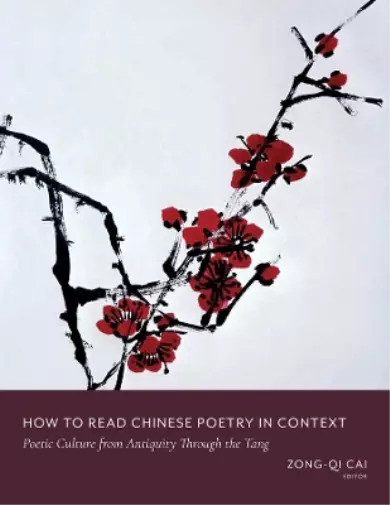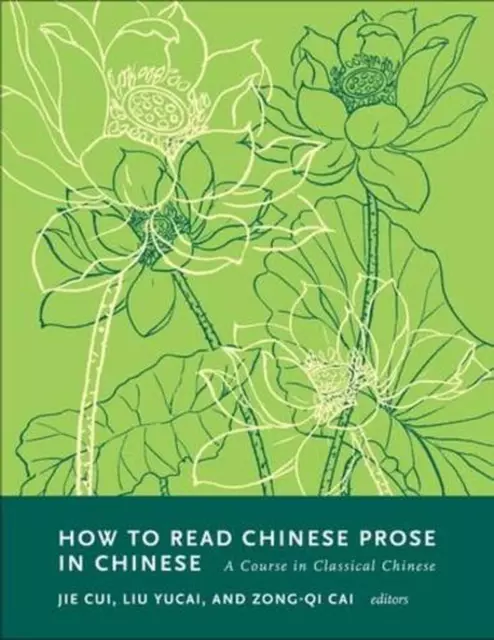How to Read Chinese Poetry Workbook by Jie Cui (English) Paperback Book
How to Read Chinese Poetry Workbook
by
Jie Cui, Zong-qi Cai
Designed to work with the acclaimed course text How to Read Chinese Poetry: A Guided Anthology, the How to Read Chinese Poetry Workbook introduces classical Chinese to advanced beginners and learners at higher levels, teaching them how to appreciate Chinese poetry in its original form. Also a remarkable stand-alone resource, the volume illuminates China's major poetic genres and themes through one hundred well-known, easy-to-recite works. Each of the volume's twenty units contains four to six classical poems in Chinese, English, and tone-marked pinyin romanization, with comprehensive vocabulary notes and prose poem translations in modern Chinese. Subsequent comprehension questions and comments focus on the artistic aspects of the poems, while exercises test readers' grasp of both classical and modern Chinese words, phrases, and syntax. An extensive glossary cross-references classical and modern Chinese usage, characters and compounds, and multiple character meanings, and online sound recordings are provided for each poem and its prose translation free of charge.
A list of literary issues addressed throughout completes the volume, along with phonetic transcriptions for entering-tone characters, which appear in Tang and Song--regulated shi poems and lyric songs.
Publisher Description
Designed to work with the acclaimed course text How to Read Chinese Poetry: A Guided Anthology, the How to Read Chinese Poetry Workbook introduces classical Chinese to advanced beginners and learners at higher levels, teaching them how to appreciate Chinese poetry in its original form. Also a remarkable stand-alone resource, the volume illuminates China's major poetic genres and themes through one hundred well-known, easy-to-recite works.
Each of the volume's twenty units contains four to six classical poems in Chinese, English, and tone-marked pinyin romanization, with comprehensive vocabulary notes and prose poem translations in modern Chinese. Subsequent comprehension questions and comments focus on the artistic aspects of the poems, while exercises test readers' grasp of both classical and modern Chinese words, phrases, and syntax. An extensive glossary cross-references classical and modern Chinese usage, characters and compounds, and multiple character meanings, and online sound recordings are provided for each poem and its prose translation free of charge. A list of literary issues addressed throughout completes the volume, along with phonetic transcriptions for entering-tone characters, which appear in Tang and Song–regulated shi poems and lyric songs.
Notes
How to Read Chinese Poetry is now the textbook to buy for those who wish to teach classical Chinese poetry to undergraduates. It is comprehensive and thoughtful in its selections, and the readings are authoritative yet accessible, showcasing a variety of interpretive methods and possibilities. The format in which the Chinese text is presented, along with its pronunciation in pinyin and English translation, not only facilitates textual analysis but also meets the growing needs of bi-lingual students. -- Wang Ping, author of The Age of Courtly Writing: Wen xuan Compiler Xiao Tong (501--531) and His Circle This is, by far, the most comprehensive and useful collection of traditional Chinese poems that will serve a broad range of readers and purposes for many years to come. General readers will find it an excellent guidebook on the major themes, forms, and techniques of Chinese poetry. For students of the language, it is a great tool for studying both classicaland modern Chinese. Teachers won't have to pore through numerous anthologies of Chinese poetry for course material any more. The impressive breadth and depth, the thoughtful design and organization, of this workbook, meets all of their pedagogical and intellectual needs. -- Michelle Yeh, University of California, Davis
Author Biography
Jie Cui is a Ph.D. candidate in the Department of East Asian Languages and Cultures at the University of Illinois, Urbana-Champaign. She is currently working on a dissertation entitled "Gu Tang Shigui and the Making of Commented Poetry Anthologies in Seventeenth-Century China" and has extensive experience teaching Chinese. She assisted in the editing of How to Read Chinese Poetry: A Guided Anthology. Zong-qi Cai is professor of Chinese, comparative literature, and medieval studies at the University of Illinois, Urbana-Champaign. He is the author of The Matrix of Lyric Transformation: Poetic Modes and Self-Presentation in Early Chinese Pentasyllabic Poetry and Configurations of Comparative Poetics: Three Perspectives on Western and Chinese Literary Criticism. He has also edited A Chinese Literary Mind: Culture, Creativity, and Rhetoric in Wenxin Dialong; Chinese Aesthetics: The Ordering of Literature, the Arts, and the Universe in the Six Dynasties; and How to Read Chinese Poetry: A Guided Anthology.
Table of Contents
Preface Symbols and Abbrevations Unit 1. Love: The Voice of Men P01 "Guan P02 Willow Branch (Liu Yuxi) P03 Untitled (Li Shangyin) P04 To the Tune "Southern Tune Exercises Unit 2. Love the Voice of Women P05 To the Tune "Southern Tune P06 There Is One I Love (anon.) P07 Prolonged Longing (Bai Juyi) P08 To the Tune "A Twig of Plum Blossom" (Li Qingzhao) P09 To the Tune "Deeply Drunk in the East Wind": Spring Passions (Xu Zaisi) Exercises Unit 3. Fields and Gardens P10 Returning to Live on the Farm P11 On Drinking Wine P12 Visiting My Old Friend's Farmstead (Meng Haoran) P13 Written on Master Huyin's Wall Exercises Unit 4. Landscape: Excursions P14 An Outing to the Eastern Field (Xie Tiao) P15 Zhongnan Mountain (Wang Wei) P16 To the Tune "West River Moon": An Even Journey on the Path to Huangsha (Xin Qiji) P17 An Outing to Villages West of the Mountains (Lu You) Exercises Unit 5. Landscape: Grand Scenes P18 The Yellow Crane Tower (Cui Hao) P19 Watching the Waterfall of Mount Lu (Li Bai) P20 Four Quatrains P21 Dreaming Heaven (Li He) P22 A Quatrain on the Spring South of the Yangtze (Du Mu) Exercises Unit 6. Landscape: Chan (Zen) Vision P23 Written for the Meditation Lodge (Chang Jian) P24 Visiting the Xiangji Temple (Wang Wei) P25 The Deer Fence (Wang Wei) P26 The Lodge in the Bamboo Grove (Wang Wei) P27 Calling-Bird Brook (Wang Wei) Exercises Unit 7. Landscape: Random Sketches P28 The Dawn of a Spring Day (Meng Haoran) P29 Sitting Alone in the Jingting Moutains (Li Bai) P30 River Snow (Liu Zongyuan) P31 Drinking on the Lake P32 A Small Pond (Yang Wanli) P33 To the Tune of "Sky-Clear Sand": Autumn (Bai Pu) Exercises Unit 8. Landscape: A Source of Wisdom P34 Climbing Crane Tower (Wang Zhihuan) P35 Departing Baidi in the Morning (Li Bai) P36 Written on the Wall of the West Wood Temple (Su Shi) P37 Two Poems Written After Reading Exercises Unit 9. Parting P38 Nineteen Old Poems P39 A Weicheng Tune (Wang Wei) P40 Sending off Meng Haoran (Li Bai) P41 To Wang Lun (Li Bai) P42 Song of a Traveling Son (Meng Jiao) Exercises Unit 10. Sojourns of the Wandering Men P43 An Overnight Stay by the Jiande River (Meng Haoran) P44 The Jiang and Han Rivers (Du Fu) P45 Nightly Mooring at the Maple Bridge (Zhang Ji) P46 Early Morning Journey in the Shang Mountains (Wen Tingyun) P47 To the Tune "Sky-Clear Sand": Autumn Thoughts (Ma Zhiyuan) Exercises Unit 11. Frontiers and Wars P48 Songs of Liangzhou P49 Following the Army (Wang Changling) P50 Setting Out for the Frontiers (Wang Changling) P51 Two Songs of Liangzhou P52 Upon Hearing of the Recapture of Henan and Hebei by the Government Army (Du Fu) P53 Crossing the Sea of Loneliness (Wen Tianxiang) Exercises Unit 12. Homesickness P54 Random Notes Upon Returning to My Hometown (He Zhizhang) P55 On the Double Ninth Festival: Thinking of My Brothers in Shangdong (Wang Wei) P56 Miscellaneous Poems P57 Quiet Night Thoughts (Li Bai) P58 Crossing the Sanggan River (Jia Dao) P59 Night Rain: A Poem Sent to the North (LI Shangyin) Exercises Unit 13. Plaints of Young Women (I) P60 Nineteen Old Poems P61 Spring Lament (Jin Changxu) P62 Untitled (Li Shangyin) P63 To the Tune "On the Water Clock at Night" (Wen Tingyun) P64 To the Tune "Buddha-Like Barbarian" (Wen Tingyun) Exercises Unit 14. Plaints of Young Women (II) P65 To the Tune "Audience at Golden Gate" (Wei Zhuang) P66 To the Tune "Crows Call at Night" (Li Yu) P67 To the Tune "Butterflies Lingering Over Flowers" (Ouyang Xiu) P68 Spring at Wuling (Li Qingzhao) Exercises Unit 15. Plaints of Palace Ladies P69 Jade Stairs Resentment (Xie Tiao) P70 Lament of the Jade Stairs (Li Bai) P71 Song of the Autumn of the Abiding Faith Hall P72 Autumn Evening (Du Mu) P73 Chang'e (Li Shangyin) Exercises Unit 16. Depiction of Things: Sensuous P74 In Praise of Pear Blossoms on the Pond (Wang Rong) P75 Brocade Zither (Li Shangyin) P76 Small Plum Tree in a Garden in the Hills P77 Plum Blossom (Wang Anshi) P78 Crabapple (Su Shi) P79 A Quatrain on Plum Blossoms (Lu You) Exercises Unit 17. Mediation on History: Famous People P80 Meditation on Ancient Ruins P81 The Diagram of Eight Formations (Du Fu) P82 Sui Palace (Li Shangyin) P83 To the Tune "The Charm of Niannu": Mediation on the Past at Red Cliff (Su Shi) P84 To the Tune "South Village": Meditation on the Past on the Beigu Pavilion (Xin Qiji) Exercises Unit 18. Mediation on History: Rise and Fall of Dynasties P85 Autumn Mediations P86 Black Clothes Alley (Liu Yuxi) P87 Red Cliff (Du Mu) P88 The Book-Burning Pits (Zhang Jie) P89 To the Tune "Sheep on Mountain Slope": Meditation on the Past at Tong Pass (Zhang Yanghao) Exercises Unit 19. Reflection: In Response to Scenes and Events P90 A Song on Ascending Youzhou Terrace (Chen Zi'ang) P91 Spring Scene (Du Fu) P92 The Qu River P93 Climbing Hi (Du Fu) P94 A Weary Night (Du Fu) P95 The Advent of Autumn (Du Fu) Exercises Unit 20. Reflection: Remembering Things Past P96 Dispelling Sorrow (Du Fu) P97 To the Tune "Beautiful Lady Yu" (Li Yu) P98 To the Tune "Sand in Silk-Washing Stream" (Yan Shu) P99 To the Tune "River City" (Su Shi) P100 To the Tune "Phoenix Hairpin" (Lu You) Exercises List of Literary Issues Discussed List of Entering-Tone Characters Character List Answer Key to Unit Exercises
Promotional
How to Read Chinese Poetry is now the textbook to buy for those who wish to teach classical Chinese poetry to undergraduates. It is comprehensive and thoughtful in its selections, and the readings are authoritative yet accessible, showcasing a variety of interpretive methods and possibilities. The format in which the Chinese text is presented, along with its pronunciation in pinyin and English translation, not only facilitates textual analysis but also meets the growing needs of bi-lingual students. -- Wang Ping, author of The Age of Courtly Writing: Wen xuan Compiler Xiao Tong (501-531) and His Circle This is, by far, the most comprehensive and useful collection of traditional Chinese poems that will serve a broad range of readers and purposes for many years to come. General readers will find it an excellent guidebook on the major themes, forms, and techniques of Chinese poetry. For students of the language, it is a great tool for studying both classicaland modern Chinese. Teachers won't have to pore through numerous anthologies of Chinese poetry for course material any more. The impressive breadth and depth, the thoughtful design and organization, of this workbook, meets all of their pedagogical and intellectual needs. -- Michelle Yeh, University of California, Davis
Details
ISBN0231156588
Author
Zong-qi Cai
Short Title
HT READ CHINESE POETRY WORKBK
Pages
232
Publisher
Columbia University Press
Language
English
ISBN-10
0231156588
ISBN-13
9780231156585
Media
Book
Format
Paperback
Year
2012
Imprint
Columbia University Press
Place of Publication
New York
Country of Publication
United States
Series
How to Read Chinese Literature
Publication Date
2012-03-06
Translated from
English
UK Release Date
2012-03-06
AU Release Date
2012-03-06
NZ Release Date
2012-03-06
US Release Date
2012-03-06
DEWEY
895.1109
Audience
General
We've got this
At The Nile, if you're looking for it, we've got it. With fast shipping, low prices, friendly service and well over a million items - you're bound to find what you want, at a price you'll love!
TheNile_Item_ID:137711375;
- Condition: Brand new
- ISBN-13: 9780231156585
- Publication Year: 2012
- Format: Paperback
- Language: English
- Book Title: How to Read Chinese Poetry Workbook
- Item Height: 279mm
- Author: Jie Cui, Zong-Qi caï
- Publisher: Columbia University Press
- Topic: Literature
- Item Width: 216mm
- Number of Pages: 232 Pages
PicClick Insights - How to Read Chinese Poetry Workbook by Jie Cui (English) Paperback Book PicClick Exclusive
- Popularity - 0 watchers, 0.0 new watchers per day, 173 days for sale on eBay. 0 sold, 3 available.
- Best Price -
- Seller - 1,209,949+ items sold. 1.8% negative feedback. Great seller with very good positive feedback and over 50 ratings.
People Also Loved PicClick Exclusive

NEW BOOK How to Read Chinese Poetry Workbook by Zong-qi Cai (2012)
$71.66 Buy It Now 27d 21h
Jie Cui Zong-qi Cai How to Read Chinese Poetry Workbook (Paperback)
$73.41 Buy It Now 1d 21h
Zong-qi Cai Jie Cui How to Read Chinese Poetry Workbook (Paperback) (US IMPORT)
$96.55 Buy It Now 2d 9h
How to Read Chinese Poetry Workbook (How to Read Chinese Literature)
$109.00 Buy It Now 24d 23h
How to Read Chinese Poetry Workbook (How to Read Chinese Literature)
$107.00 Buy It Now 27d 13h
Zong-qi Cai How to Read Chinese Poetry in Context (Hardback)
$296.52 Buy It Now
Zong-qi Cai How to Read Chinese Poetry (Paperback)
$109.10 Buy It Now
How to Read Chinese Prose in Chinese: A Course in Classical Chinese by Zong-qi C
$57.83 Buy It Now
